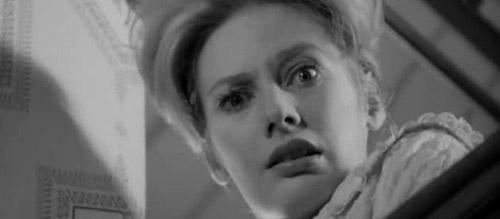Carnival of Souls (1962) Review
This article was written exclusively for The Film Magazine by Scott Z. Walkinshaw.
Carnival of Souls (1962)
Director: Herk Harvey
Screenwriter: John Clifford
Starring: Candace Hilligoss, Sidney Berger, Frances Feist, Art Ellison, Herk Harvey
A director’s influence is often a sign of the strong, illustrious career they have built over time. What a bittersweet thing it is, then, to find a director whose work is so influential, yet entirely singular. Such is the case of Herk Harvey, whose only feature film remains 1962’s eerie chiller Carnival of Souls. Like Charles Laughton’s The Night of the Hunter (1955), Harvey’s film is an example of so much directorial promise never to be seen again. However, like other genre classics, the shadow of Carnival of Souls has been cast on the rest of horror cinema history.
The film begins with a drag race between two cars which quickly leads up to a wooden bridge. One of the cars loses control and plummets into the river below. When the townsfolk gather and dredge the river, they struggle to find the car or its three inhabitants. Eventually, a lone woman, Mary Henry (Candace Hilligoss), emerges on the bank, dazed and covered in mud. It is unclear how she pulled herself free from the sunken wreckage, but within a couple of days she has decided to leave her accident in the past and start a new life in Salt Lake City, taking a position as a church organist. She seems unaffected by her ordeal until she is startled by a ghostlike face shining in the middle of the road. As much as Mary tries to settle into her new home, she cannot escape the gaze of the ghoul or the abandoned pavilion that seems to hold an untold spell on her.
An interesting central character for 1962, Mary is largely a self-assured, solitary person. Despite her position as an organist, she seems to reject religion, and much like The Haunting’s Eleanor Lance, there are undertones of possible homosexuality or asexuality that provide an entirely different personality to the genre for this time. Mary spends a lot of her time blocking the relentless advances of her neighbour John Linden, a recognisable kind of slime who mistakes Mary’s fear of being alone for sexual interest. Further condescension and dismissal come from the other men in town, often in supposedly safe spaces like the church or a doctor’s office. On more than one occasion, Mary finds herself stepping into a reality in which she literally cannot be seen or heard, but even before this it seems she is destined to be ignored.
Carnival’s dreamlike narrative almost feels like a precursor to Kubrick’s The Shining, with Mary floating from scene to scene, blindly drawn to the places that call her. Like that film, there is a persisting feeling of personal isolation, and the foreboding sense that something may be paying attention to you after all. Mary’s watcher comes in the form of the ever-silent man (played by Harvey himself), black-eyed and pallid-faced, like a skull there to remind her of the fate she inexplicably escaped. Or has she? Is this a spiritual entity hell-bent on dragging her back to the darkness she avoided, or the psychological manifestation of her trauma beginning to creep into her life? The beauty of Carnival lies in this ambiguity.
The movie’s imprint can be seen on the filmography of David Lynch, and films like The Sixth Sense, both in story and style. Even Tim Burton’s Beetlejuice appears to owe a debt to Harvey’s ghostly fable. So why has Carnival of Souls not become a household name like the other hallmarks of 60s horror?
Being an independent film meant a lack of prominent distribution, and, due to copyrighting errors, the film instantly fell into the American public domain, existing in multiple different cuts depending where it played. Even more-so than fellow indie Night of the Living Dead, however, it never feels cheap despite its shoestring budget of just over $30,000 – the European influence of Bergman adding a touch of aesthetical class to Harvey’s industrial filmmaking techniques and understanding. Still, there is arguably no other genre in which a film benefits more from being branded a cult classic. If Carnival can’t join the ranks of the A-listers, there is certainly no shame in its dedicated following of midnight screenings and festival showings that revived its rightful reputation within the horror canon.
With its black & white cinematography and sinisterly askew atmosphere, fans of ‘The Twilight Zone’ should find much to enjoy in Carnival of Souls. By modern standards, the film may not illicit as many scares as it would have on release, but like Hill House or the Overlook Hotel, it is hard to look at the Saltair pavilion without expecting to see a hundred eyes looking back at you from its dark recesses. The question is, do you dare to look?
20/24
Written by Scott Z. Walkinshaw
You can support Scott Walkinshaw in the following places:
Twitter – @scottfuzz
Letterboxd – /scottfuzz


